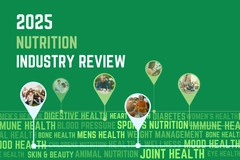
- Industry news
Industry news
- Category news
- Reports
- Key trends
- Multimedia
Multimedia
- Journal
- Events
- Suppliers
Suppliers
- Home
- Industry news
Industry news
- Category news
- Reports
- Key trends
- Multimedia
Multimedia
- Events
- Suppliers
Suppliers
“Now we know how much we don’t know”: Chr. Hansen addresses HMOs for infant gut health at Microbiome Forum
26 May 2023 --- The importance of Human oligosaccharides (HMOs) and gut health focus from the early stage of life was highlighted at the Microbiome & Probiotic R&D and Business Collaboration Forum Europe in Rotterdam, the Netherlands, earlier this week.
At the forum, NutritionInsight spoke with Yannik Schönknecht, a scientific advisor at Chr. Hansen, about the company’s latest research in HMOs, what future science looks like and common misconceptions the public has about gut health.
“The journey of HMOs is just about to start. On the one hand, HMOs will be combined with probiotics. HMOs are prebiotic and if you combine them with probiotics, you can have very effective potential tools to modulate the microbiome and other systems beyond.”
He notes that HMOs are candidates for the indications in the adult population, according to research.
He explains that HMOs are the third most abundant component in human milk. There are 150 to 200 structures in human milk and, in recent years, the ability to manufacture them has boosted research.
“Naturally, HMOs can be applied for infant formula because some infants cannot be breastfed.”
 HMOs can be applied for infant formula because some infants cannot be breastfed.HMOs and health
HMOs can be applied for infant formula because some infants cannot be breastfed.HMOs and health
When asked whether HMOs bring these benefits to health directly or if they are modulated through the gut microbiome, Schönknecht said, “it’s both.”
“On the one hand, you have HMOs, and they are prebiotic, so they modulate the growth of beneficial bacteria, but on the other hand, HMOs show direct effects independent of the microbiome. They can directly bind to different immune cells supporting the maturation and they can directly bind to intestinal cells supporting the resilience and development of the gut.”
“Even some data show that HMOs are being absorbed and can reach the systemic blood circulation, and there could also be some direct interaction with the continent of development,” Schönknecht adds.
In the last 10 to 20 years, interest has been growing around HMOs, and there have been advantages in the measurement technologies and the production capabilities of those, he explains:
“It’s a challenging methodology to get samples from your gut. You need to analyze fecal and DNA samples for the DNA to identify which bacteria is which. We had some huge breakthroughs in the biotechnological processes.”
“We see an interaction between the microbiome and certain health outcomes, not only for digestion but also for other parts like the immune system and that opens up the possibility to modulate all of these health areas.”
Prior research
Schönknecht adds that HMOs are still in their infancy stage.
“About 30 clinical trials have been performed so far, since 2015, and these clinical studies were performed in infants, some were performed in children, but also adults, and they consistently show the safety and the tolerability of HMOs.”
“So that has been centered now, and we’re coming into a new generation of studies looking into what health benefits can be reproduced by supplementing manufactured HMOs. At Chr. Hansen, we performed a study in infants where we added five HMO structures to infant formula, and where we could show that it modulates the stooling pattern.”
“You have a shift of the studied pattern toward breastfed infants, which is always the gold standard. At the conference, we present some new data on microbiome modulation, where you can also see you have a boost in Bifidobacteria.”
He emphasizes that it is possible to change the microbiome composition into the direction of breastfed infants, which is associated with improved health outcomes.
“We have a lot of research collaborations with other academic groups. We’re going for preclinical or in vitro systems, where we try to understand the mode of action because there’s still a lot uncovered. For example, how HMOs bind to immune cells,” notes Schönknecht.
He added that research shows other benefits beyond the microbiome modulation, like influencing the immune system, influencing or supporting the gastrointestinal system, and even cognitive development is influenced by HMOs.
“That opens huge possibilities for other health areas and other age groups beyond infancy, and we will discuss all the signs that there is a limited number of clinical studies. There is a huge trend in preclinical studies in vitro to understand the mode of action better.”
Misconceptions about the gut He further notes that there are also other bacteria which are commensal bacteria.
He further notes that there are also other bacteria which are commensal bacteria.
Schönknecht says that a common misunderstanding is that there is no such thing as one single and healthy microbiome, but it differs between people, age, lifestyle and physical activity.
“There is no black and white in the microbiome bacteria. There are some bacteria like Bifidobacteria, those which are seen as generally beneficial.”
He further notes that there are also other bacteria which are commensal bacteria, which sometimes fall off the record because they may not have a direct beneficial effect. Still, they’re not harmful or don’t have any health concerns.
“Finally, if you look at microbiome research, it focuses on the bacteria, which is the most researched part of the microbiome. However, they are also viruses, fungi and other microbes in the microbiome which outnumber the bacteria and scientists. There’s so much more we must look into.”
“We are at a stage where we know how much we don’t know, for example, to define a healthy microbiome.”
Recently, Chr. Hansen hosted a webinar about HMOs, where it provided an overview of the current evidence on HMOs and discussed how to further substantiate the promising potential for food applications.
By Beatrice Wihlander, reporting from the 11th Microbiome & Probiotic R&D and Business Collaboration Forum Europe












